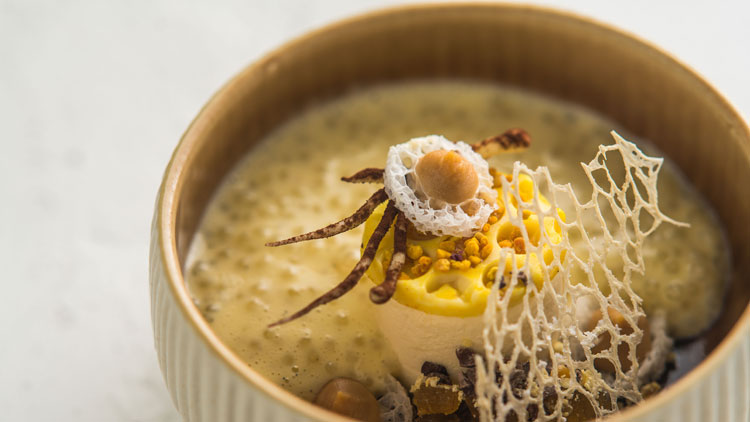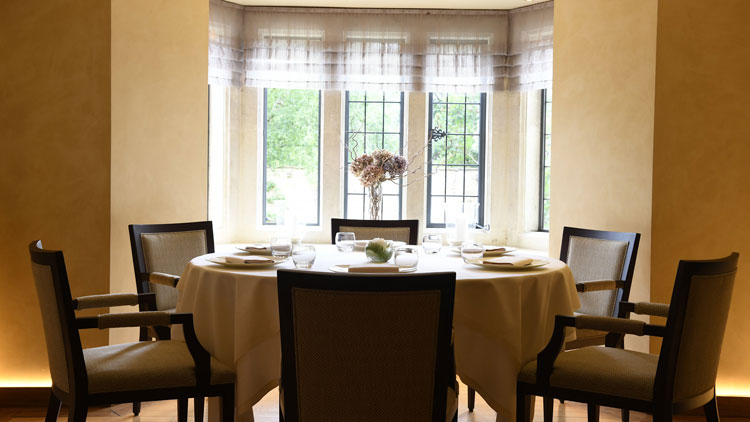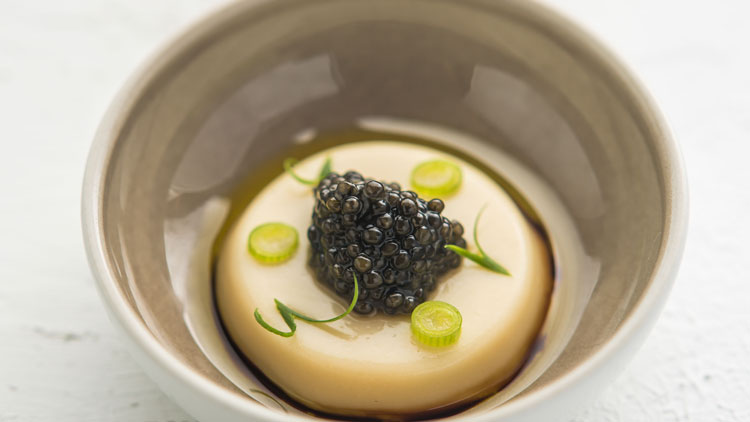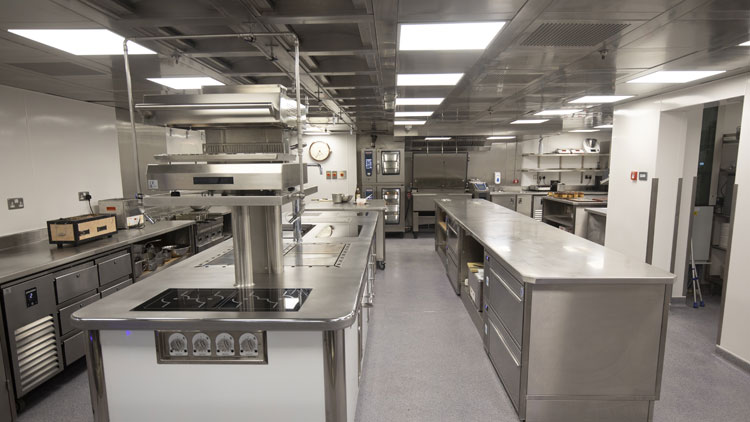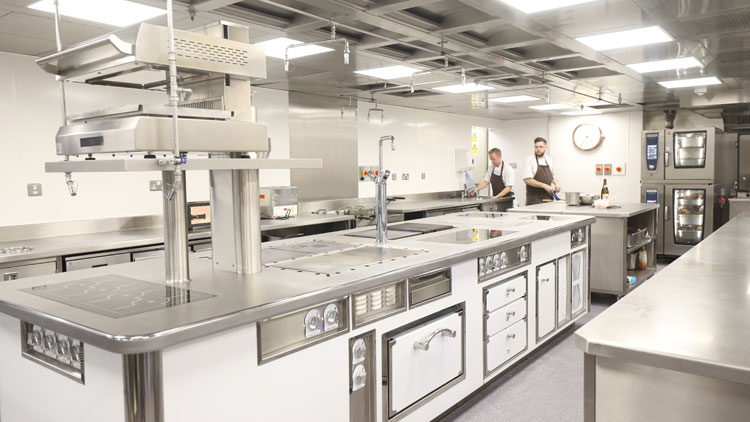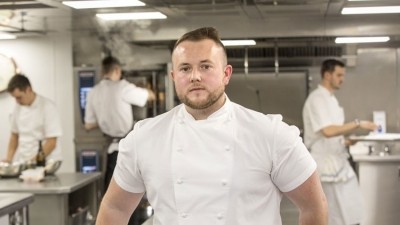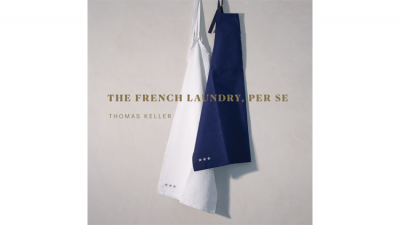Sponsored by Nisbets in place
Niall by mouth: how Whatley Manor's executive chef is modernising country house hotel dining
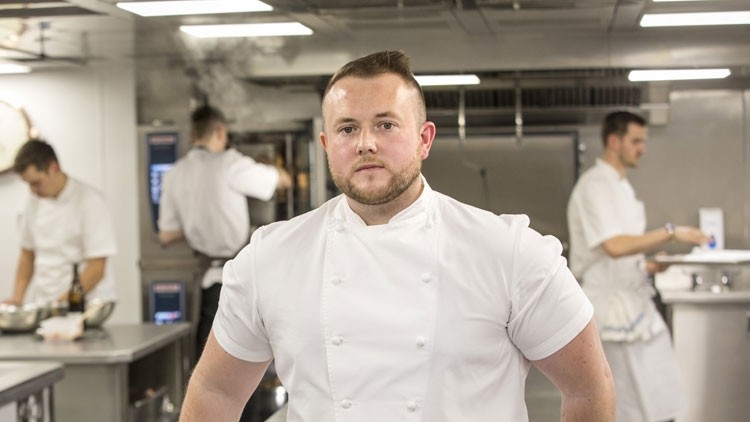
Niall Keating is the owner of a fingerstache; a tattoo of a moustache that allows him to simulate facial hair by placing his index finger between nose and lip.
About 20 minutes after getting it done he decided an explanation was required, so followed up with some more ink on his forearm, which reads: “the only restrictions we have in this life are the ones we impose upon ourselves”.
A decade or so on, he admits the drunkenly chosen inspirational quote falls short in explaining his finger tat, but he has followed the advice throughout his brief yet distinguished kitchen career.
Keating – who has a thickset, muscular build that’s reminiscent of his former employer Sat Bains – exhibits a quiet determination that’s seen him rocket through the kitchen ranks both in the UK and abroad. He took on his current position of executive chef at high-profile Cotswolds country house hotel Whatley Manor when he was just 25.
Older chefs often cite youngsters aspiring to run their own kitchens before fully mastering their craft as one of their principle headaches. While some will still say that’s too young to have taken on the hotel’s (then) two-Michelin-starred The Dining Room restaurant, Keating has proved a prodigious and unflinching talent. Updating Whatley Manor’s steadfastly classical dining offer has not been easy, but he has held his ground.
While the now 28-year-old was unable to hold onto the outgoing chef Martin Burge’s two Michelin stars in the 2018 guide – doing so would have been nothing short of a miracle – he did retain one star (depending on how you want to spin it, it would also be accurate to say he won one, or indeed lost one).
More impressively, a year or so later he achieved international recognition from the little red book, taking home the inaugural Michelin Young European Chef of the Year award. He beat four older and more established chefs at the ceremony, which took place in Budapest.
So what’s it like to become a poster boy for the respected restaurant guide in your mid-20s? “To be handed an award in front of pretty much every three-star chef in Europe was incredible. I’d only been a Whatley for a year and a bit. I didn’t think I had a chance. Then they called my name out, it was nuts. It was one of the best days of my life,” says Keating, who was also tasked with cooking a dish for attendees, although most present were apparently too busy necking champagne to eat it.
Keating certainly hasn’t let the award go to his head, and he also doesn’t think it is necessarily an indication that Michelin believes he has what it takes to win a second star.
“Of course I’d like to think that. But I suspect it’s more about promoting the next generation of chefs,” he says. “The most important thing about the award from my perspective is that it shows Michelin thinks we’re doing the right thing at Whatley. It’s been an amazing morale boost for the team, too.”
Though Keating’s rise through the ranks has been unusually swift, he doesn’t appear to be impatient for accolades. In fact, he even says that a large part of him was relieved when he didn’t retain the second star.
“I’m sure a lot of people were hoping I’d retain. But if I had people would have said ‘well, it had two stars anyway’. They wouldn’t have felt like mine. The way I see it, I won that star for my cooking. I’m 100% happy with how it turned out.”
A humble start
Born in Stoke, Keating didn’t do badly at school but eschewed academia in favour of a career that would give him instant access to cash. He started out as a kitchen porter at his local pub but – on the advice of his father – soon started to explore working in more top-end establishments.
“He sat me down and told me that if I wanted to be successful and be paid properly I needed to cook at a high level. That’s always stuck with me,” says Keating, who experienced his first Michelin-starred establishment when he was just 16, completing a two-week stage at Restaurant Martin Wishart in Edinburgh.
Intoxicated by the rigour and focus required by top kitchens, he took a job as a breakfast chef at The Bath Priory in Somerset under Sam Moody. This would prove a pivotal moment in his career. He went from making toast and slinging eggs to sous chef of a Michelin-starred restaurant in fewer than four years. It was here he also met high-profile general manager Sue Williams.
It’s unusual for the boss of a hotel with overall responsibility for 50 or so members of staff to take an interest in the career of a lowly commis chef, but that is exactly what happened at The Bath Priory.
“He was just 18 when I met him. Even as a very junior member of staff, there was something about his attitude that stood out. He was capable with a strong work ethic and very calm,” says Williams, who is now Keating’s boss again as general manager at Whatley Manor.
Stepping up his game
When Keating had gone as far as he could go in Bath, he went to work at Restaurant Sat Bains (Williams recommended him to Bains). “It just felt like the place to be. He had two stars and his book had just come out (Too Many Chiefs Only One Indian). I’d done classic and was looking for something a bit more cutting edge and the opportunity to really challenge myself.”
Keating found the challenge he was looking for within Bains’ notoriously demanding kitchen, arriving as a sous chef from a Michelin-star restaurant and within just a few hours feeling like a commis chef again (he was recruited as a chef de partie).
“I lacked the creative and analytical skills required to cook at that level. I had a one dimensional approach to food. In a classic kitchen you fillet a mackerel and then pan-fry it. In Sat’s kitchen you need to understand ingredients and think about why they’re handled in a certain way. Sat and John (Freeman, head chef ) would often say ‘how would you cook it if you’d never seen it before?”
Keating describes the atmosphere in Bains’ kitchen as “intense”. “Sat is an intense guy and that rubs off on everything. There’s not much movement on anything. He likes things to be exactly as he wants them, and that’s fair enough. Some people enjoyed it more than others, but there was very little movement in the team in the two years I was there.”
California dreaming
Bains arranged a stage for Keating at Daniel Patterson’s Coi in San Francisco. Upon finishing the stage – and again on Bains’ recommendation – Keating dined at Benu, which now has three Michelin stars. “The meal I had that night had such a powerful effect on me I knew I had to work there. At that point I thought I had a good understanding of cooking processes. But with every dish served at Benu I could not fathom how they got there,” says Keating, who after returning to the UK wrote to Benu’s Korean-American chef patron Corey Lee asking for a job.
Lee agreed, and within just a few months Keating was living out of a cheap hotel working in one of the most progressive kitchens in the US. The way he speaks about his time at Benu leaves little doubt as to which restaurant has left the biggest impression on him.
“I still miss that kitchen. I remember walking in there for the first time and seeing how clean and precise and organised it was. The level of professionalism was just incredible. It was one-of-a-kind food. Perfectly simple. There’s no other way I can describe it.”
He was especially taken by Lee himself who, prior to opening Benu, was chef de cuisine at Thomas Keller’s The French Laundry (also in Northern California). “To watch him demonstrate a technique is mesmerising. Even something as apparently simple as risotto. It’s flawless. You’ll think something he has made is perfect, and then he’ll adjust it and you’ll understand that it wasn’t. It’s almost like he has a sixth sense for food.”
Keating appears sad that his time there ended prematurely. Lee was keen for him to stay on but after his J-1 visa ran out was unable to continue to employ him (the US requires foreign chefs to have advanced cooking qualifications to apply for another visa, and Keating never went to college).
Perhaps another reason for what feels like an uncharacteristic display of emotion is that Keating also met his Danish-Indonesian wife Laetizia at Benu. She is also a chef and is currently employed by fishmonger and restaurateur Robin Moxon.
He followed her to Denmark, taking a job as chef de cuisine at Michelin-starred Copenhagen restaurant Kong Hans Kaelder. Despite his youth, he performed well but only stayed for a year after meeting with Williams in London and being offered the job at Whatley Manor (rumour has it that Corey Lee was also interested in employing Keating for a possible London opening).
Bumpy beginnings
Though he appears unfazed by it, he hasn’t had an easy ride at Whatley Manor, which is located in the southern part of the Cotswolds, about 20 minutes from Chippenham.
Keating took over the kitchen from Burge at Christmas 2016. A new and largely unproven chef stepping into the shoes of an established two-Michelin star chef was always going to be tricky, but it was especially tough for Keating. “It’s the only time my age has been an issue,” he says of his first few months at the hotel. “They had no respect for me and could not understand why I was replacing Martin Burge. I do get it, but some of the behaviour was unacceptable.”
Burge loyalists were openly hostile , ignored his instructions and, Keating claims, some even attempted to sabotage the operation by ordering excessive amounts of perishable stock. All have now left, with a number now working with Burge at his new posting at the northern end of the Cotswolds in Farncombe Estate.
Keating has also encountered significant resistance from customers. He is one of a handful of chefs trying to bring country house hotel dining kicking and screaming into the present day by cooking modern food with Asian influences (his peers include Gareth Ward at Ynyshir in Powys and Tom Kemble at South Lodge in West Sussex).
TripAdvisor gives a good insight into the challenges he faced in the early days, with regulars penning long comments querying his appointment and approach. These earnestly typed missives – which must occasionally have made difficult reading for Keating and Williams – reveal a highly conservative attitude towards fine dining and bafflement at the introduction of stronger, less familiar flavours.
“There are lots of restaurants where you can have classic food and a very similar experience. Where’s the fun in that? I want people to think ‘wow, what are we eating now’. I want The Dining Room to be recognised as a restaurant that challenges its guests.”
Williams admits that some have questioned her decision to employ Keating and that The Dining Room is now a difficult sell for 15% to 20% of the hotel’s clientele. “Change is awkward and communications with guests can be difficult. This was a two-star property and Niall had never won a star, not even an AA Rosette. I question myself about plenty of things, but employing Niall is not one of them. As fantastic as Martin was, I didn’t want to put another classical chef in as that would have resulted in too many comparisons.”
A significant investment
With the backing of Whatley Manor’s Swiss owners the Landolt family, Williams has doubled down on F&B since her appointment, making significant investments in the hotel’s restaurant spaces and –more recently – signing off on a refit that has given Keating a world-class kitchen.
Bringing in Keating – who also oversees Whatley Manor’s The Greys Brasserie and small plates restaurant The Green Room – is a play to attract the next generation of diners to the hotel.
Classic and excessively formal restaurants can be a turn-off to younger guests, and with just 23 bedrooms and three different food offers, Whatley Manor needs to appeal to the local market rather than just hotel guests (young Bristol and Bath foodies are a key target for Keating and Williams).
Looking eastwards
Like most young chefs that have worked at very distinctive places, Keating admits it hasn’t been easy to find his own style but is now happy with his menu, which has heavy Asian influences.
“It’s funny because I’m kind of sick of seeing the word yuzu on other people’s menus. But I was immersed in Asian food at Benu, which is a modern American restaurant focused on Korean and Chinese ingredients and techniques. It was all new to me, but when you cook with these things every day you get an understanding of how and why they’re used. I’m hooked.”
Keating says it is inevitable that his cooking is influenced by the places he has worked and finds copycat accusations tedious. “How many country house hotels are cooking venison with braised red cabbage and chestnut puree? I can name a dozen. Nobody is calling them out.”
Keating offers a single £120 tasting menu in The Dining Room (although vegetarian and vegan options are available). The meal starts in Keating’s space age kitchen with a selection of snacks – pomelo marinated in chilli and lime, tempura eel with perilla, and a melon fresca dotted with caviar oil.
Dishes served in the dining room include Perigord truffle custard garnished with gold leaf (a take on chawanmushi); a risotto laced with a powerful chorizo puree that’s topped with raw scallop; a xiaolongbao-like tortellini dish in pork fat sauce; and salmon paired with yeast buerre blanc.
The creative, finely-tuned cooking makes sense within the confines of the futuristic kitchen but feels a bit disconnected from The Dining Room, a small space with a traditional look and feel. The restaurant is only open four nights a week, which suggests demand may not be quite where Keating and Williams want it to be at the moment. He would almost certainly be having a smoother ride if he’d chosen to open in a city. Alongside a comparatively remote location and a conservative customer base, Keating also has to devote much of his bandwidth to the hotel’s two other restaurants as well as breakfasts and afternoon tea. So are they any regrets?
If anything, the challenges have given the 28-year-old experience beyond his years. “When I arrived here I felt like I had to have control over everything, but I soon realised that’s impossible,” he says. “I’ve had to get better at delegating.”
And, with his new kitchen, he’s here for the long haul he insists, paying back the trust that Williams put in him early on. “I’m here because of Sue. I accept that I’m young for the role, but I feel like I can make a difference here. With Sue’s help, we can get it to where we want it to be.”
Keating’s kitchen: Whatley Manor’s state-of-the-art new kitchen is a statement of intent for Niall Keating and his team
Niall Keating compares his new kitchen to the bridge of a spaceship, and he isn’t too far off the mark. A brightly-lit mix of brilliant white and carefully buffed stainless steel, it contrasts with Whatley Manor’s relatively traditional look and feel.
The no-expense-spared space is a statement of intent: a world-class kitchen that – it is hoped – will allow the hotly-tipped young chef to take his food to the next level.
It’s certainly a step up from what was there before. “We limped into 2019 with the last kitchen, in fact we barely made it. Christmas was tough,” Keating recalls. “It was as if the kitchen could sense the end was close and started to give up. Everything was breaking down. At one point we had 17 chefs trying to cook with just one oven.”
The Cotswolds hotel has a curious back-of-house setup. There are two kitchens servicing three different restaurants: the main kitchen does Keating’s flagship The Dining Room and the main courses for The Grey’s Brasserie, while a smaller, fully open kitchen services the small plates-focused The Green Room and is where the starters and salads for The Grey’s Brasserie are prepared (it was refitted soon after Keating joined the hotel). The pastry section in the main kitchen does the desserts for all three restaurants.
While it might sound like a logistical nightmare, Keating says it works. “The Green Room kitchen keeps a lot of traffic out of the main kitchen, which is helpful when we need to concentrate on The Dining Room. I’ve no idea how the arrangement came about, space reasons I guess.”
Keating oversees a brigade of 17 chefs and four kitchen porters. The Dining Room is open four evenings a week. On Fridays and Saturdays the whole team works but in the week – which can be quiet – it varies.
While there’s no chef’s table in the main kitchen, all The Dining Room guests are given the option of having their snacks there. The prospect of a steady flow of guests into the space meant Keating had to think carefully about both the layout and the equipment (no areas of the kitchen are off-limits to guests).
Standing around a pair of high bar tables opposite the pass, diners have a theatre-style view into the kitchen with nearly every single section and member of staff on show.
An excessively hot environment wasn’t workable so the new kitchen is gas-free. Keating has also sought to reduce noise levels where possible. Eschewing gas means a quieter stove and more hushed ventilation because there’s less heat to take out of the kitchen.
The kitchen has an L-shaped pass; one side serves The Dining Room and the other is for The Grey’s Brasserie. Dishes are generally plated within each kitchen section and brought to the pass for inspection by Keating and his senior team by front-of-house staff.
Both of the passes back on to a French-made bespoke Athanor cooking suite finished in white enamel, which is unquestionably the kitchen’s most head-turning bit of kit.
The single biggest benefit of the new space is the instant boost in staff morale. “It’s undoubtedly changed the way we cook and allowed us to work at a much higher and more professional level. Refitting the kitchen has been a crucial part of developing our food outlets and has allowed us to increase efficiency and create a more memorable guest experience.”
The cooking kit that makes Whatley Manor’s new kitchen tick
Athanor suite
Keating’s beautiful French-made cooking suite comprises four induction hobs, two planchas, a pass-through-oven, heat draws, integrated water boiler and a rise-and-fall infrared salamander grill. He was so excited about the kit, he flew to France to watch the finishing touches being put to it.
Rational intelligent cooking kit
To the rear of the kitchen are three units manufactured by Rational: two combi-ovens stacked on top of each other and a Rational VarioCooking Centre with pressure cooking function. Keating is especially taken with the latter. “It allows us to make better quality sauces and stocks, and because of the pressure cooker element we can do it in half the time,” he says. “It’s also extremely useful for staff food. We need to feed a whole hotel’s worth of personnel, up to 50 a day. It’s also very easy to clean because it has its own water and drainage system. All of the Rational kit is very high-tech, I can control all three from my phone if I like.”
Refrigeration
Alongside a walk-in fridge, refrigeration is taken care of by Adande draws and precision reach-ins. The former offer flexibility – they can turn from fridge to freezer at the flick of a switch – while the latter can fit full-size gastronorm pans.
Pacojet
The micro pureeing of frozen foods is a well-established technique in ambitious kitchens. Pacojets are convenient and allow chefs to create ultra-fine textures, but they are rather noisy. Keating’s solution is to place his in a specially commissioned sound-proofed cupboard. “They had one in Benu, although it was for the benefit of the staff rather than guests. It’s a noisy piece of kit but if you close the cupboard door you can’t hear it all,” he says.
